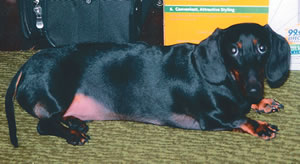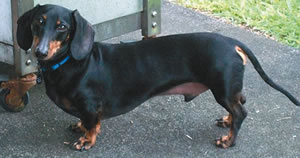The Problem With Pudgy Pooches

Wednesday - November 21, 2007
|
 Del.icio.us
Del.icio.us
|
A few years ago, Mr. Pono, the wiener dog, weighed in at a whopping 17 pounds. This was bordering on obese for my not-so-miniature dachshund.
I would feed Pono boy lots of yummy snacks, which he really enjoyed, using it as just another way to show him how much I cared about his happiness.
But in that picture, Pono does-n’t look too happy, does he?
According to the American Animal Hospital Association, obesity is one of the most common medical conditions affecting dogs and cats in the United States. Recent studies show that 30 percent to 40 percent of pets are overweight and 25 percent are obese.
The other day I was watching a show on Animal Planet, It’s Me Or The Dog. In this episode, there was a British woman who grossly overfed her dachshund, Jess, as a way of showering her with affection.
The woman’s daughter said, “They are like best friends, my mom and Jess. But I have a best friend too, and I don’t shove a Mars Bar in her mouth every time I see her.”
According to Dr. Douglas K.Y. Chang, veterinarian at Aloha Animal Hospital, one of the biggest problems regarding this disease in pets comes from the owner’s deep need to nurture.
“Part of how we express our nurturing is by feeding,” says Chang. “We feed them, they eat, so we feel good. And we tend to feed them the foods that are junk foods - those treats that are tasty and rich.”
This, says Chang, coupled with a sedentary lifestyle makes for a whole lot of pudgy pooches.

|
“Animals are in the house a lot,” he says. “They don’t have to go out and hunt for their food. They’re protected, food appears as if from heaven each day, and all that energy required to do those things that the body is built for isn’t necessary anymore.”
Similar to humans, too much weight causes health issues for pets such as respiratory problems, heart disease, diabetes and arthritis. Overweight pets also have a greater chance of tearing ligaments and wearing down their joints.
“Just about every system is affected by obesity, and this really shortens your pet’s life expectancy,” says Chang. “Pets weigh much less than people, so an extra pound or two can make a big difference.”
So how can you tell if your pet is overweight? A trip to the vet will tell you. Aside from regular veterinarian visits, there are other signs your dog might be overweight: If it’s difficult to see your dog’s waist, if he or she has a broad back or it’s difficult to see his or her ribs. In addition, look for behavioral signs such as laziness, constant panting, unwillingness to play or lagging behind on walks.
For cats, many of the physical symptoms are the same. You also might notice your cat is overweight if he or she hesitates when jumping onto the furniture, has difficulty grooming properly, is tired, lazy or resists playing games.
“We fail to recognize the reality of the problem,” says Chang. “It’s very common for people to think that their pet is not over-weight.”
So the first step, says Chang, is to admit there is a problem. Then go to your vet to get a healthy target weight for your pet and start them on a better diet and exercise plan. Sometimes you can be giving the wrong foods (never feed your pet table scraps); sometimes you can be giving too much food.
If you still have the desire to ply your pets with snacks, make them healthy ones. Veggies and fruits such as apples, carrots and broccoli are good for your pet. Mr. P loves them. In fact, as I type, he is sitting at my feet hoping I’ll grant him a slice of my Fuji apple.
Today, Pono is a healthier 14.7 pounds. He seems much more lively than he was 2.3 pounds ago. I’ve come to realize that Mr. P will always look like he’s in need of a snack, but as his owner, I have to know when to say “no.”
It certainly doesn’t mean I love him any less, and it makes me feel better knowing that I’m increasing his chances of living a long, happy and healthy life.
E-mail this story | Print this page | Comments (0) | Archive | RSS Comments (0) |
Most Recent Comment(s):













